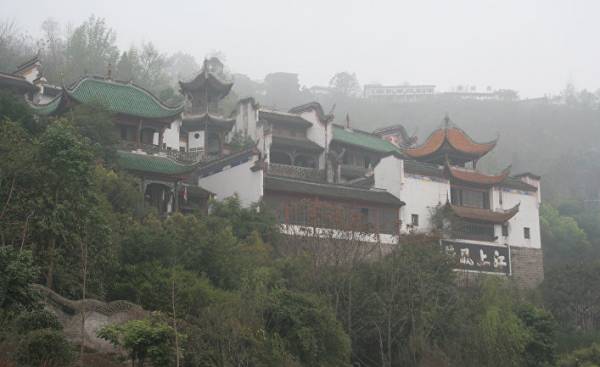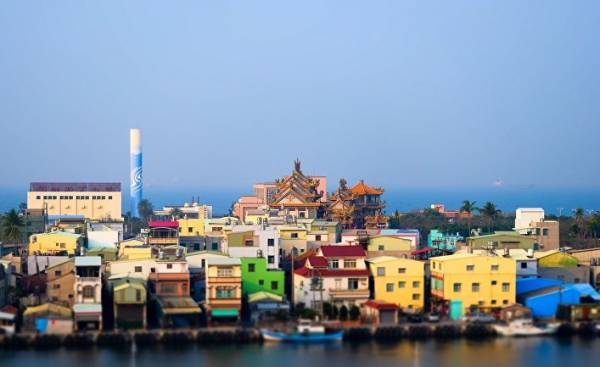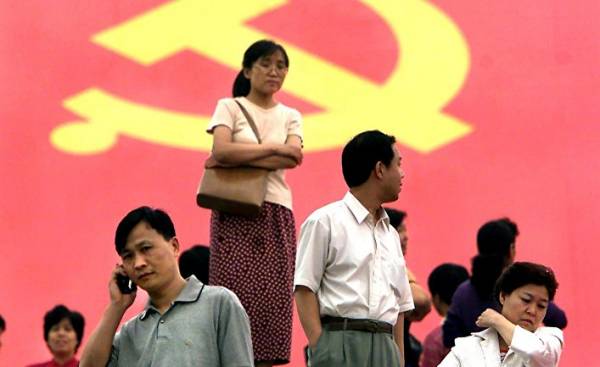
Translation carried out by the project Newочем
In XVIII and XIX centuries the sun, as we know, never went on the British Empire. Her iron will was put into practice by a powerful Navy, although the status quo and were provided by the ports, highways and Railways. The infrastructure that the British built everywhere, wherever they appeared, provided and maintained power, how the veins and bones in the human body.
Great Nations have done so since the days when Rome paved 89 thousand kilometres of roads and pipelines in Europe. In the nineteenth and twentieth centuries Russia and the United States has left its mark, penetrating and taming the surrounding area with projects like the TRANS-Siberian and Transcontinental Railways.
Now it is the turn of China. Beijing achieved a lot by using the “capture of resources” in Africa and many other places, the military construction of artificial Islands in the South China sea and recently presented the strategy of the landing of naval forces at sea.
 © RIA Novosti, Alexander vilf | go to fotobounce on the coastal part of the city of Kaohsiung
© RIA Novosti, Alexander vilf | go to fotobounce on the coastal part of the city of Kaohsiung
And yet these supposedly predatory ambitions of China, no one usually does not associate with each other. Meanwhile, around the world begins to materialize the whole infrastructure. Is to fold it with the ambitious initiatives of Chinese companies, and we see that witnessing the birth of the global commercial Empire in history.
China considers their views true. Financed and built by China’s dams, highways, Railways, pipelines, seaports and airports can be found (now or soon) everywhere, from Samoa to Rio de Janeiro from Saint Petersburg to Jakarta, from Mombasa to Vanuatu, from the Arctic to Antarctica. Many of them were built for service supply from existing (or planned) mines, oil fields and other enterprises in China or world markets.
Such a Grand picture demands that Beijing thought out plan, but also reflects the indomitable and commercial madness. Chinese companies randomly create new businesses and make deals. They are mainly looking for opportunities for development abroad, and this process turned out to be difficult to manage from home. All this is also true for the fast-growing power.
“What is happening is consistent with what one would expect from other great powers, whose military position is correlated with the economy and diplomatic status,” reported Quartz, Lyle Morris, an expert on China at the RAND (American strategic research centre — approx. Newочем)
Below are the components of this system that already exist or will be built soon.
The story begins with rethinking the silk Road…
In September 2013 the newly declared Chinese leader XI Jinping visited the capital of Kazakhstan, Astana. He came to town to seal the deal for China to buy shares for $5 billion in Kashagan, one of the largest oil fields in the world. During this visit, he unveiled a plan ultimately named “One belt, One Road” (Single Zone, single Road) — new version of the legendary silk Road, passing both by sea and by land.
A daring idea to the limit
On land Beijing plans to build high-speed rail network. She will take the start in Kunming, capital of Yunnan province, will join with Laos including Cambodia, Malaysia, Myanmar, Singapore, Thailand and Vietnam.
Another network of Railways, roads and energy routes will begin in XI’an, Central China, and will reach Belgium. As was written earlier, Beijing has started construction of 12 892-kilometer freight railway line between Chinese city of Yiwu and Madrid, Spain. Finally, another 1 810-kilometer high-speed railway will start in Kashgar and will be built to the South through Pakistan to the Arabian sea to the port of Gwadar. The idea of creating new railway lines is not new — as mentioned above, China is creating this system for some time.
At sea the Maritime silk road of the XXI century (see blue dotted line on the map 1) connects the South China sea with the Indian and Pacific oceans (the southern part of the latter). China intends to protect its Maritime borders. May 26, China announced a strategy for the expansion of the Navy. It is planned that he will not only be based along the country’s coast, but out into the open sea.
China don’t need to create thousands of kilometers of Railways and other ways. Much of the infrastructure already exists, is the whole point, to tie it all together.
Will require large-scale public works. In order to make it happen, Beijing needs to be careful so generously sharing such major construction and engineering plans. To date such contracts were regarded as rare and great opportunity for Chinese state-owned industrial institutions. These include the China railway Corporation, whose initially inflated stock prices often go up when stocks once the overseas Empire fell. If the local infrastructure companies are not going to stick an adequate price policy, they will be thrown back almost everywhere.
Anyway, it’s not going to happen. In his recent letter to shareholders Jonathan Fenby, an expert on China from the firm Trusted Sources, suggested that the plans the Chinese may be too ambitious. China is known for the fact that the first announces the project and then abandons them. So it was with the construction of the railway, the budget of which amounted to $ 3.7 billion in February, it was canceled by Mexico under the pretext of rampant corruption. Meanwhile, Japan challenged China’s plans. It introduced a competitive bidding project for the construction of high-speed railway trunk line cost $ 1 billion and other projects in Indonesia, Thailand and many other countries. While the Japanese interest rates are lower, and technology is often better.
But Beijing seems aware of his real capabilities. And yet the world may help with the construction of the infrastructure through another brainchild of China — the Asian infrastructure investment Bank. It 57 the founding members, and thus he is free from the world Bank. Projects supported by this Bank have a positive effect on the state of the country in which they are earned. But with the huge influence of China, these institutions will become part of China’s global infrastructure.
 © AFP 2016, StringerМолодожены on a roller coaster in the theme Park Happy Valley in Wuhan
© AFP 2016, StringerМолодожены on a roller coaster in the theme Park Happy Valley in Wuhan
… extends into South America…
Chinese railway project in South America — a way for trains to be routed through the Amazon jungle
XI Jinping pledged $ 250 billion in investment in South America over the next ten years. Main stage — construction 5311-kilometer high-speed railway worth 10 billion dollars (the dashed red line above), which will start in ACU near Rio de Janeiro, cross the Amazon rainforest and the Andes mountains and ends on the Peruvian coast (Volume Ashburn, researcher, National public radio, had a great hour programme about the railway).
On top of that, Chinese billionaires Jing Wang offers $50 billion to build a canal through Nicaragua length at 273.5 kilometers.
… and in Africa…
In January, China agreed to help the African Union in the construction of railroads (see map), highways and airports to connect all 54 African countries. These projects are already being implemented, including the construction of: 1 408-km railway, at a cost of 13 billion dollars, along the coast of Nigeria; 805-km railroad, costing $ 3.8 billion, connecting the cities of Kenya, Nairobi and Mombasa; 740-km railroad, costing $ 4 billion, linking the cities of Ethiopia Addis Ababa and Djibouti; also 1368-kilometer railway network to Chad, valued at $ 5.6 billion.
Have China’s ambitions at sea. It is planned the construction of a modern port in the capital of Tanzania Dar-es-Salaam, the capital of Mozambique, Maputo, Libreville, Gabon, Ghana tema, the capital of Senegal Dakar.
All of these terrestrial and marine projects directly related to Chinese investments in the mining industry on the continent. For example, the Chinese national petroleum Corporation engages in large-scale oil projects in Chad and Mozambique, and the Chinese manufactory quickly build a factory in Ethiopia that rely on cheap local labor.
The new Chinese Empire and seeps to your neighbors…
Except that planned high speed rail link in Malaysia and Singapore, Laos and South-East Asia, China plans to hold a channel in the Thai KRA isthmus, deep-sea container port and industrial zone in Kuantan, Malaysia, as well as to invest $ 511 million in the expansion of the airport in male, the capital of the Republic of Maldives.
… and Oceania
China wants to gain power not only over the South China and East China seas, but also on the countries of Oceania. According to the Lowy Institute, China has allocated $ 2.5 billion for transportation and as trade credit, countries of the South China sea. Among his projects you can find such as:
Fiji: hydroelectric power station at a cost of 158 million dollars, several sports complexes, including the Vodafone stadium in Suva, accommodating up to 4 thousand spectators.
Samoa hospital at a cost of $ 100 million in apía, building and runway Faleolo airport at a cost of $ 40 million, and the pier in Vaiusu worth $ 140 million.
Tonga: Palace of St. George, government building, on which took $ 12 million, two little Chinese turboprop aircraft for internal use of airline Real Tonga. This deal was highly controversial — the vessel is not licensed for use in the East.
Vanuatu: two of the turboprop aircraft, but this time for Air Vanuatu. $ 60 million spent on the construction of the Parliament buildings and for the construction of dormitories for University of South Pacific, in Port Vila. (Both of the debt was forgiven)
Pakistan is extremely important to the Chinese silk road…
Why China gave Pakistan the infrastructure of $ 42 billion? Countries have long been allies. But China has a goal: he wants to pacify the Uighur rebels responsible for the unrest in Western Xinjiang province. Some of them asylum on the territory of Pakistan and Afghanistan. Beijing is a great burden on both countries, wishing to persuade them to release the Uighurs living there.
 © AFP 2016, Stephen ShaverПекинцы on the background of the party flag
© AFP 2016, Stephen ShaverПекинцы on the background of the party flag
Sending goods through Pakistan, China can no longer use the Strait of Malacca. Most of China’s oil and other natural resources transported through this narrow, 800-km-long isthmus between Malaysia and Indonesia. The government fears that if relations with Washington deteriorate, the US will block the isthmus and will deprive the country of vital resources. This is one of the reasons due to which China is sponsoring a deepwater port on the Arabian sea in Gwadar, high speed highway long 1800 kilometers high-speed railway and oil pipeline in the Chinese city of Kashgar.
… and Central Asia…
Central Asia for more than two hundred years, was almost fully under the influence of Russia. And still, if to consider only brute force. But China is rapidly increasing its muscles.
All relationships are based around oil and natural gas. More than half of all gas supplies to China Turkmenistan. This occurs via three pipelines with a length of 1,800 kilometers, it is planned the construction of the fourth. China is the only country that Turkmenistan allows to extract the gas. For example, from Galkynysh, the second largest gas field in the world. The share of China in one of the largest fields in the world, Kashagan, located in the territory of Kazakhstan $5 billion, XI also signed a 15-billion deal to supply gas and uranium from Uzbekistan.
… and Russia
Two years ago, Russia announced a reorientation towards China. The result was the construction of two pipelines with natural gas (most marked on the map by red dots), through which will be one fifth of the entire supply gas to China. The deal has flaws, but they are constantly working — construction will begin soon. In addition, China promised to build a high-speed rail link between Moscow and Beijing. The journey will take 6 days, now with the TRANS-Mongolian railway, and only two days.
China accelerates the delivery of goods to Europe…
The Maritime silk road (blue line in the tenth map) will deliver the goods via the Greek port of Piraeus, China has invested $ 260 million. From there the goods will go by rail to the Balkans. Chinese ships will also dock in Lisbon Portuguese and German Duisburg. To develop its network in the heart of Europe, China has agreed to Finance the construction of high-speed Express price in the $ 3 billion from Belgrade to Budapest. New Chinese railway and its length is 12 thousand kilometers from Yiwu to Madrid beats yet the slower shipping methods.
… and captures the real estate market in the United States
While the Chinese network has not spread to the United States. However, the fact that has already been built, will be the starting point for the conquest of the huge American market. In the United States plan to build high-speed trains, Chinese companies are trying to grab the contract for a price of one billion dollars for the construction of messages between San Francisco and Los Angeles, which is estimated to cost $ 68 billion. Chinese CNR Corp. has provided Boston 284 subway passenger car whose total value comes out to $ 566 million.
Of adds fuel to the fire is the fact that the US is the most popular market for Chinese real estate investment (look at graph above). This applies to nuggets such as the Waldorf-Astoria in new York (sold for $ 1.95 billion Angbar Insurance) and chase Manhattan Plaza (Fosun bought for $ 725 million). But the large amounts of rich Chinese investors spent in cash, buying residential real estate.
And last, but not least, China plans for North and South poles
Though from China to the Arctic circle, thousands of miles away, China still calls itself the “polar country.” Chinese oil company Cnooc Ltd owns a large share in the production of oil and natural gas on the territory of Iceland, Beijing has also organized the yellow river — a research center on the island of Spitsbergen belonging to Norway. China 4 research stations in Antarctica — like structures allow Nations to proclaim his possession over parts of the continent. The fifth station plan to place in a place called Indescribable Island. She will begin the extraction of resources when the agreement of 1959 on the inviolability of local nature expire in the year 2048.
China’s infrastructure, worldwide, can meet the economic interests of the West. But not so much that it could be considered intentional. Some of the most advanced transport infrastructures, located not only in China but around the world, not just related to China. They aim to make the world economy more conducive to Chinese trading activities.
This Chinese ambitions do not become something bad or threatening. They just focused on China. It is worth remembering that this way of doing things is not the invention of China. As Quartz said Michael Pillsbury, the author of “a century of Race,” China’s ambition is rooted in “the sense of fierce competition that they, the assurances derived from the behavior of America in the 1800-ies”.







